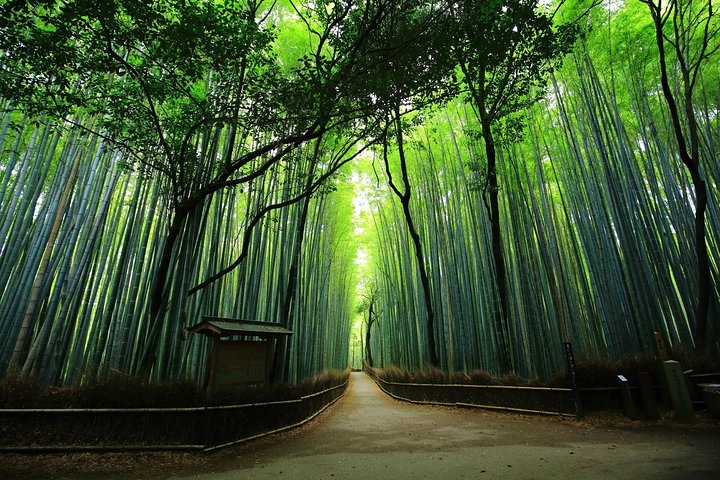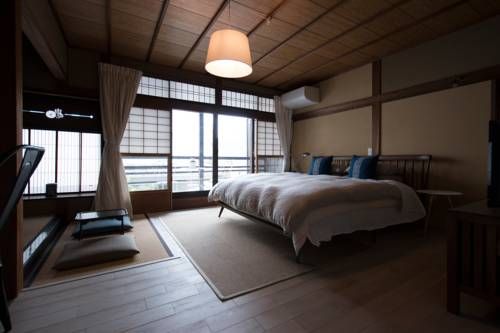Why choose this Kyoto tour ?
Accompanied by a government-licensed and experienced multilingual guide, explore the area of Arashiyama and Sagano, where aristocrats once unwound in their villas more than 1,000 years ago.
The highlights of this tour include the scenic countryside views from Togetsukyo bridge; Tenryu-ji temple with its beautiful traditional gardens; the enchanting world from within the Bamboo Grove; and Jojakko-ji Temple with its breathtaking green moss. During the tour you will also visit some secret spots unfamiliar to the usual tourists.
Enjoy the walk and delicious food while learning about Japanese culture and history. Our guides are looking forward to arranging a tour that’s best for you!
Note*1: Please select your must-see spots from a list in the tour information to create your customized itinerary.
Note*2: The National Government Licensed Guide Interpreter certification is issued by the Japanese government requires a good knowledge and understanding of Japanese culture and history.
Make the most of your Kyoto adventure
What makes Kyoto Arashiyama & Sagano Bamboo Private Tour with Government-Licensed Guide a unique experience ?
Arashiyama (嵐山) is a pleasant, touristy district in the western outskirts of Kyoto. The area has been a popular destination since the Heian Period (794-1185), when nobles would enjoy its natural setting. Arashiyama is particularly popular during the cherry blossom and fall color seasons.
The Togetsukyo Bridge is Arashiyama’s well known, central landmark. Many small shops, restaurants and other attractions are found nearby, including Tenryuji Temple, Arashiyama’s famous bamboo groves and pleasure boats that are available for rent on the river.
The Togetsukyo Bridge (lit. “Moon Crossing Bridge”) is Arashiyama’s most iconic landmark. It was originally built during the Heian Period (794-1185) and most recently reconstructed in the 1930s. The bridge looks particularly attractive in combination with the forested mountainside in the background. A riverside park with dozens of cherry trees is located just adjacent to the bridge.
The walking paths that cut through the bamboo groves make for a nice walk or bicycle ride. The groves are particularly attractive when there is a light wind and the tall bamboo stalks sway gently back and forth. The bamboo has been used to manufacture various products, such as baskets, cups, boxes and mats at local workshops for centuries.
Shugakuin Imperial Villa (修学院離宮, Shugakuin Rikyū) was built in the 17th century by Emperor Gomizuno and is now managed by the Imperial Household Agency. It consists of the Upper, Middle and Lower Villa areas, each featuring gardens and buildings of the traditional imperial style.
Shugakuin’s name comes from a former temple built on the same site in the tenth century. The Imperial Villa was constructed between 1655 and 1659, with a palace for Gomizuno’s daughter added ten years later. More recently in 1964, the surrounding farmlands were bought by the Imperial Household Agency. They are leased out to local farmers who continue to work the fields.
Katsura Imperial Villa (桂離宮, Katsura Rikyū) is one of the finest examples of Japanese architecture and garden design. The villa and garden in their present form were completed in 1645 as the residence for the Katsura Family, members of Japan’s Imperial Family.
Visiting Katsura Imperial Villa requires joining a tour. The tour follows the garden’s circular walking trail around the central pond. Palace buildings can be viewed only from the outside, and photographing is allowed only from designated spots. Tours in English are available.
Kurama (鞍馬) is a rural town in the northern mountains of Kyoto City, less than one hour from the city center. Kurama is best known for its temple Kurama-dera and its hot spring, one of the most easily accessible hot springs from Kyoto.
Outdoor and indoor baths can be enjoyed at Kurama Onsen, a ryokan located at the upper end of the town of Kurama. It can be reached in a 10 minute walk from the train station along the town’s only road or along a nature trail following the river. Staying guests can use the baths for free, while daytrippers pay 2500 yen to use all of the baths or 1000 yen for just the outdoor bath (rotemburo).
Yoshiminedera (吉峰寺) is a temple of the Tendai sect of Japanese Buddhism located in Kyoto’s western mountains. Similar to Kiyomizudera on the opposite side of town, Yoshiminedera is built along the mountain side and looks out onto Kyoto. The temple grounds are spacious and there are many buildings distributed up the mountain side.
A priest from Enryakuji, named Gesan, established Yoshiminedera as a personal retreat in 1029. In 1467 the temple was destroyed in the Onin War but was rebuilt in 1621. The temple’s main objects of worship are a Kannon statue carved by Gesan and a Kannon statue given to the temple by Emperor Gosuzaku in 1042.
Daikakuji (大覚寺) is a large temple in the northern part of Kyoto’s Sagano district. It was originally built in the early 800s as the detached palace of Emperor Saga, who thoroughly enjoyed spending time in this calm area on the outskirts of Kyoto. Thirty years after the emperor’s death, the palace was converted into a temple and has since been one of the highest ranked temples of Shingon Buddhism.
Daikakuji has had a role in several significant historical events. A succession of retired emperors reigned from here, and in the 12th century the temple hosted peace talks that reunited the Northern and Southern Imperial Courts after 50 years of civil war. Daikakuji is also featured in the Tale of Genji, the first novel in Japanese literature. Today, the temple is one of the best places to still feel the ancient court atmosphere described in the novel and is often used for filming historical dramas.
Daikakuji is a temple of the Shingon sect of Japanese Buddhism. Formerly the residence of an emperor, the buildings were converted into a temple in 876. During its history the temple traditionally had members of the imperial family serve as the head priest. Beside the main temple buildings there is a large pond and a pagoda.
This is the former villa of the popular actor Okochi Denjiro (1896-1962), located in the back of Arashiyama’s bamboo groves. Okochi Sanso consists of several different gardens and buildings, including living quarters, tea houses and gates. The buildings can only be viewed from the outside.
Ranked among Kyoto’s five great Zen temples, Tenryuji is the largest and most impressive temple in Arashiyama. Founded in 1339 at the beginning of the Muromachi Period (1338-1573), the temple is one of Kyoto’s many UNESCO World Heritage Sites. In addition to its temple buildings, there are attractive gardens with walking paths.
Katsura Imperial Villa (桂離宮, Katsura Rikyū) is one of the finest examples of Japanese architecture and garden design. The villa and garden in their present form were completed in 1645 as the residence for the Katsura Family, members of Japan’s Imperial Family.
Visiting Katsura Imperial Villa requires joining a tour. The tour follows the garden’s circular walking trail around the central pond. Palace buildings can be viewed only from the outside, and photographing is allowed only from designated spots. Tours in English are available.
This mountainside temple was founded in 1596. With small, attractive buildings and gates, the temple has a quiet and understated atmosphere. Maple trees and moss are located just beside the paths and stairs that lead across the temple grounds. From a number of spots, visitors can enjoy views over Kyoto.
Similar to Jojakkoji, Nisonin Temple is a hillside temple with slightly larger and imposing buildings. A generally understated atmosphere on the temple grounds is partly due to the overhanging trees along approach. Founded in the mid 9th century, Nisonin is a temple of the Tendai sect. There are views over the city from the upper grounds.
Gioji is even more nestled into the forest than Jojakkoji and Nisonin. It is known for its moss garden that is punctuated with tall maple trees. The temple’s entrance gate and small main hall have thatched roofs. The latter has an attractive round window looking into the gardens.
Tour Description & Additional Info:
- Specialized infant seats are available
- Service animals allowed
- Public transportation options are available nearby
- Infants and small children can ride in a pram or stroller
- All areas and surfaces are wheelchair accessible
- Transportation options are wheelchair accessible
- Suitable for all physical fitness levels
- Wheelchair accessible
Options To Choose for Your Trip:
- Kyoto Arashiyama & Sagano Bamboo Private Tour with Government-Licensed Guide
Add
Pickup included
Kyoto Arashiyama & Sagano Bamboo Private Tour with Government-Licensed Guide Inclusions:
Included with Your Ticket
- Customizable Walking Tour of your choice of 3-4 sites from ‘What to expect’ list
- Meet up with guide in Kyoto
- Licensed Local English Speaking Guide
- The pick up/drop off for this tour is on foot.
Not Included
- Lunch – Lunch (for yourself)
- Entrance fee (for yourself)
- Transportation fee (for yourself and your guide)
- Private Vehicle
- Other personal expenses
- You cannot combine multiple tour groups.
- Guide Entry fees are only covered for sights listed under What to Expect.
Trending Kyoto Nearby Tours Likely To Sell Out
Special Instructions:
- This Tour is Provided by Japan Guide Agency.
- Tour Timezone & Starts at Asia/Tokyo.
- Mobile or paper ticket accepted.
- For a full refund, cancel at least 24 hours before the scheduled departure time.
- This Tour is Rated 4.5 Stars based on 47 valid reviews on VIATOR.
- Minimum 1 Travelers is required to book.
- Maximum 10 Travelers is accepted for booking.









